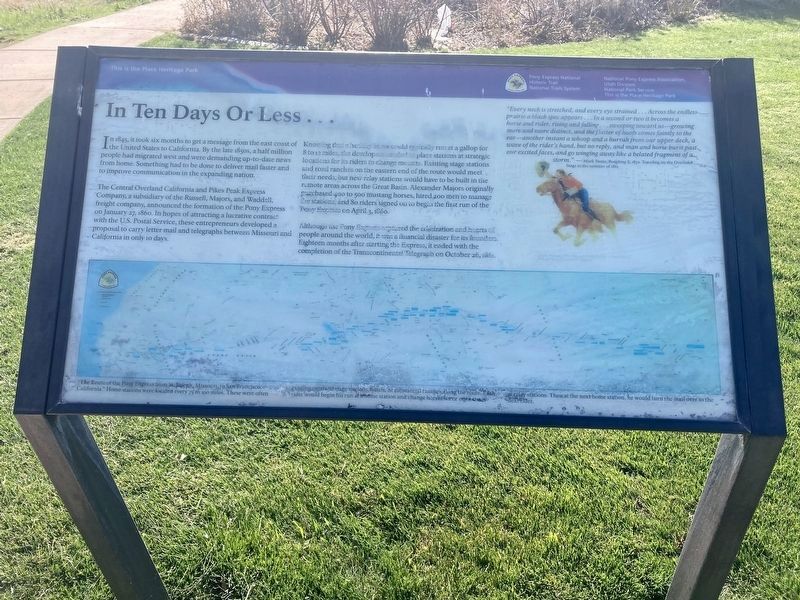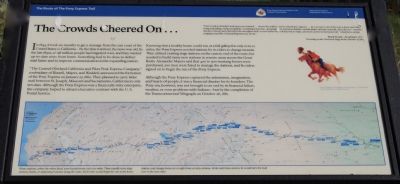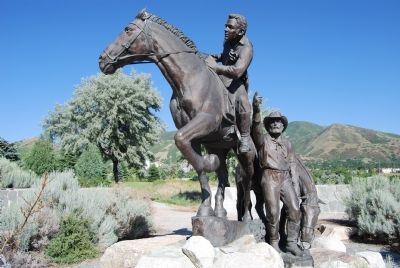University in Salt Lake City in Salt Lake County, Utah — The American Mountains (Southwest)
In Ten Days or Less...
“The Central Overland California and Pikes Peak Express Company,” a subsidiary of Russell, Majors, and Waddell, announced the formation of the Pony Express on January 27, 1860. They planned to carry letter mail between St. Joseph, Missouri and Sacramento, California in only ten days. Although the Pony Express was a financially risky enterprise, the company hopes to attract a lucrative contract with the U.S. Postal Service.
Knowing that a healthy horse could run at a full gallop for only 10 to 12 miles, the Pony Express needed stations for its riders to change mounts. They utilized existing stage stations on the eastern end of the route, but needed to build many new stations in remote areas across the Great Basin. Alexander Majors said that 400 to 500 mustang horses were purchased, 200 men were hired to manage the stations, and 80 riders signed on to begin the run of the Pony Express.
Although the Pony Express captured the admiration, imagination, and hearts of people, it was a financial disaster for its founders. The Pony era, however, was not brought to end by its financial failure, weather, or even problems with Indians—but the completion of the Transcontinental Telegraph on October 26, 1861.
Topics and series. This historical marker is listed in these topic lists: Roads & Vehicles • Settlements & Settlers. In addition, it is included in the Pony Express National Historic Trail series list. A significant historical month for this entry is January 1900.
Location. 40° 45.141′ N, 111° 49.18′ W. Marker is in Salt Lake City, Utah, in Salt Lake County. It is in University. Marker is on Sunnyside Avenue, on the right when traveling east. The marker is in “This is the Place” Heritage Park. Touch for map. Marker is at or near this postal address: 2601 Sunnyside Avenue, Salt Lake City UT 84108, United States of America. Touch for directions.
Other nearby markers. At least 8 other markers are within walking distance of this marker. Answering the Call (a few steps from this marker); A Moment in Time (within shouting distance of this marker); Learn About The Pony Express (within shouting distance of this marker); Unsung Heroes (within shouting distance of this marker); Pony Express Goes to the Olympics (within shouting distance of this marker); Sesquicentennial Mormon Trail Wagontrain (about 800
feet away, measured in a direct line); This is the Place Monument (approx. 0.2 miles away); The Spanish Explorers (approx. 0.2 miles away). Touch for a list and map of all markers in Salt Lake City.
Credits. This page was last revised on February 16, 2023. It was originally submitted on June 28, 2007, by Dawn Bowen of Fredericksburg, Virginia. This page has been viewed 1,907 times since then and 13 times this year. Last updated on April 17, 2021, by Connor Olson of Kewaskum, Wisconsin. Photos: 1. submitted on April 17, 2021, by Connor Olson of Kewaskum, Wisconsin. 2, 3. submitted on June 28, 2007, by Dawn Bowen of Fredericksburg, Virginia. • J. Makali Bruton was the editor who published this page.


